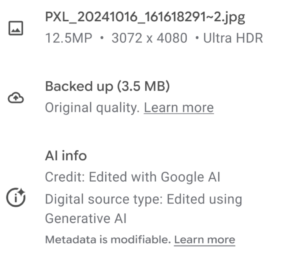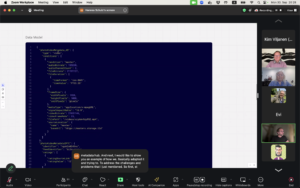Categories
Archives

On Thursday, Google announced that it will be extending its usage of AI content labelled using the IPTC Digital Source Type vocabulary.
We have previously shared that Google uses IPTC Photo Metadata to signal AI-generated and AI-edited media, for example labelling images edited with the Magic Eraser tool on Pixel phones.
In a blog post published on Friday, John Fisher, Engineering Director for Google Photos and Google One posted that “[n]ow we’re taking it a step further, making this information visible alongside information like the file name, location and backup status in the Photos app.”
This is based on IPTC’s Digital Source Type vocabulary, which was updated a few weeks ago to include new terms such as “Multi-frame computational capture sampled from real life” and “Screen capture“.
Google already surfaces Digital Source Type information in search results via the “About this image” feature.

Also, the human-readable label for the term http://cv.iptc.org/newscodes/digitalsourcetype/trainedAlgorithmicMedia was clarified to be “Created using Generative AI” and similarly the label for the term http://cv.iptc.org/newscodes/digitalsourcetype/compositeWithTrainedAlgorithmicMedia was clarified to be “Edited with Generative AI.” These terms are both used by Google.

Last week we held the latest IPTC member meeting, the IPTC Autumn Meeting 2024. With over 80 attendees, it was a great success. We heard from IPTC members and invited guests on new developments in the world of media technology and metadata.
Speakers from Axel Springer, Reuters, Global Media Registry and the EBU
We heard from Axel Springer who have implemented an internal video management system based on IPTC Video Metadata Hub as a metadata model; from Reuters who are basing their live events streaming API on the forthcoming DPP Live Production Exchange (DPP LPX) protocol based on the recently approved ninjs 3.0, from Global Media Registry who are developing a “Unique Media ID” standard to identify media publishers, and from the EBU on the Trusted European Media Data Space (TEMS) project.
Committees and Working Groups
Our new Media Provenance Committee and its Working Groups are working very hard on the details for implementing C2PA in the media industry, including launching the IPTC Origin Verified News Publisher List. We also heard from Tessa Sproule of CBC / Radio Canada on their implementation of C2PA.
Our Standards Committee Working Groups are also working hard, with new developments on all of our standards and three new standard versions, as described below.
New Versions of Sport Schema, ninjs and Photo Metadata
The Standards Committee approved three new standard versions at its meeting on Wednesday 2nd October.
IPTC Sport Schema version 1.1 was approved, adding a Club class so we can model Clubs that contain multiple Teams, even teams that play different sports (who knew that Bayern Munich had a chess team?!). The update also added Associate relationships for individual athletes (such as a coach for a tennis player or a boxer), and facets for sports so we can now declare that an event was a women’s 200 metres breaststroke swimming event using IPTC facets metadata taken from our NewsCodes sports facet vocabulary.
IPTC Photo Metadata Standard version 2024.1 modifies the text of the Keywords property to broaden its scope, matching current industry usage.
IPTC’s JSON standard for news ninjs version 3.0 was also approved, adding requirements for the DPP LPX project including events and planning information, plus renditions support for live event streams. The 3.0 version of the standard also moves property names to “camelCase”, which is the de facto standard for GraphQL and many other JSON-based technologies.
All three updates, plus the NewsML-G2 v2.34_2 errata update, will be released in the coming weeks.